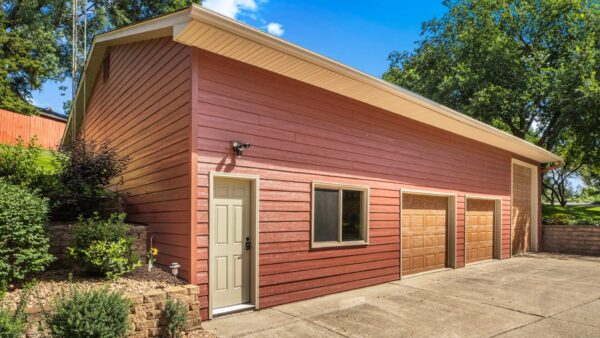Gutters are one of the unsung heroes of your home’s exterior. They quietly direct rain and melting snow away from your foundation, protecting everything from your roof to your basement. But like any part of your home, gutters wear out—and knowing when they need to be replaced can save you from bigger headaches down the road.
In this blog, we will walk you through the common symptoms of worn-out gutters and how to spot them early. From overflowing water and peeling paint to puddles near your foundation, we’ll help you identify what’s normal—and what’s not—so you can make the right call before bigger problems set in.
Common Signs of Gutter Damage Every Homeowner Should Know
When it comes to gutter damage, some signs are immediately noticeable, while others require a closer look. Keeping an eye on your gutters can help you catch issues early and avoid costly repairs. Here are a few key indicators that your gutters might need attention:
1. Sagging or Detached Gutters
If you notice your gutters starting to sag or peel away from the fascia board, this could be a sign of damaged or failing fasteners, or weakened wood. Gutters are designed to be securely attached, and if they’re no longer aligned properly, water won’t flow the way it should. Over time, this can lead to bigger issues like leaks and water damage.
2. Cracks, Rust Spots, or Corrosion
Check your gutters for visible cracks, rust spots, or corrosion, which can allow water to escape or pool in unwanted areas. Even small cracks can become major problems if left untreated, as they can quickly develop into leaks, leading to potential damage to your roof, siding, and foundation.
3. Peeling Paint and Water Streaks
Peeling paint on your gutters or streaks of water running down your siding are strong indicators that your gutters aren’t working properly. When gutters aren’t redirecting water as they should, it can cause excess moisture to spill over the sides, running down your home’s exterior. This not only damages your home’s finish but also signals improper water flow.
4. Overflowing Gutters and Pooling Water
If you see rainwater spilling over the sides of your gutters, that’s a clear sign they’re clogged or improperly pitched. Overflowing gutters can quickly lead to water pooling near your foundation, which can damage your landscaping, basement, or foundation. This is one of the most common issues homeowners face, and it’s a sign that your gutters need immediate attention.
5. Improper Gutter Slope (Pitch)
Your gutters should slope toward the downspouts to ensure that water flows away from your home. If the gutters appear to be level or are sagging in certain areas, they’re not functioning as they should. The pitch, or small angle, is crucial to proper water drainage and protecting your home from water damage. Even a slight issue with the slope can lead to pooling water, which over time will result in cracks, rust, and other forms of damage.
If you notice any of these signs, it’s a good idea to address them as soon as possible to maintain the integrity of your home.
Why Timely Gutter Replacement Matters for Your Home
Gutters are often overlooked—until they stop working. Putting off gutter replacement may seem harmless at first, but over time, those small signs of wear can lead to major damage.
When your gutters fail to channel water properly, that water doesn’t just vanish—it finds its way into the places you least want it.
Here’s what can happen when gutters aren’t replaced in time:
- Water Pooling Around the Foundation: Ineffective gutters allow water to collect at the base of your home. Over time, this can weaken your foundation, cause basement leaks, and create costly structural damage.
- Rotting Roof Edges and Fascia Boards: Water that overflows from failing gutters often backs up under roofing materials, leading to wood rot and deterioration at the roofline.
- Moisture Seeping Into Walls: Persistent leaks can result in water penetrating your walls, creating an environment for mold, mildew, and costly interior damage.
- Compromised Indoor Air Quality: Once mold starts to grow, it can impact the air you breathe—especially harmful for those with allergies or respiratory issues.
On the bright side, catching these issues early does more than protect your home. It helps keep repair costs low, maintains your curb appeal, and ensures you’re ready for whatever the seasons throw your way.
What to Do if Your Gutters Need Replacing
Are you thinking your home is in need of replacement gutters? When your gutter system can’t properly redirect water away from your home, the consequences add up quickly.
Here’s what to do next:
1. Inspect the problem areas
Take a careful (and safe) look at the gutters around your home to identify where problems may be starting and pinpoint the areas most in need of repair.
2. Don’t just patch—plan
While DIY fixes might seem convenient, they rarely solve the root problem. Professional assessments can uncover hidden damage, and in many cases, a full replacement is the most cost-effective, long-term solution.
3. Schedule a professional gutter inspection
A qualified gutter expert, like our team at Lutgen Companies, can determine whether your gutters need repair or replacement based on your home’s layout, age, and exposure to the elements.
At Lutgen Companies, we’re more than just contractors—we’re local homeowners ourselves. As a family-owned business rooted in Central Minnesota, we understand what your home is up against. Our approach to gutter replacement is proactive and precise. We tailor every system to fit your home’s architecture, using seamless, custom-sized gutters that are built to last through every season.
Learn more about how professional gutter replacement can protect your home!




